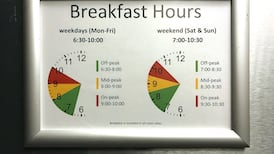There are ominous signs that the same mistakes that were made with Junior Cycle reform will be repeated with the Leaving Cert. The Association of Secondary Teachers in Ireland is dissociating itself from the current draft subject specifications for the reformed Leaving Cert subjects in biology, physics and chemistry.
The union is taking this highly unusual step because the full results of a public consultation on the initial draft specifications were not presented to the National Council for Curriculum and Assessment (NCCA) subject development groups. This included extensive reports from the Irish Science Teachers Association (ISTA) and the Irish Universities Association (IUA). Chemistry and physics were last updated in 2000 and biology in 2002. This scandalous delay makes proper reform even more vital.
Concerns were raised that the 40 per cent for the proposed individual student scientific investigation is far too high, especially in the age of generative artificial intelligence
It’s worth noting that the ISTA is a voluntary organisation. Only love of your subject and students would motivate anyone to give up evenings and Saturdays to analyse draft specifications. A forensic 200-page analysis was produced, praising what is good but also highlighting the alarming lack of clarity in significant numbers of the learning outcomes and the lack of a list of mandatory experiments. There used to be more than 20 mandatory student practicals. In the new specification, there appear to be 10 to 12 experiments, but they could just be demonstrated by a teacher. So much for active learning.
Does the lack of a list of mandatory experiments have anything to do with the fact that principals would be hammering on the Department of Education’s door for additional resources if practicals were mandatory?
READ MORE
Concerns were also raised that the 40 per cent for the proposed individual student scientific investigation is far too high, especially in the age of generative artificial intelligence. Crucially, more than four out of five teachers do not have sufficient access to laboratories, chemicals and glassware to allow each student to safely carry out such an investigation.
This means that access by non-Leaving Cert students to labs would inevitably have to be severely curtailed. Until every school has adequate facilities, inequality between privileged and disadvantaged students will be reinforced. If a professional educational researcher had done this analysis, I shudder to think of the cost. The ISTA did it for free. Many of their conclusions were echoed by the IUA report.
[ Junior Cycle reforms leave students unprepared for Leaving Cert, study findsOpens in new window ]
In a statement, the NCCA said its policy is not to circulate material on behalf of third parties. It believes that neither would it be feasible, given the substantial volume of material received by the NCCA during consultations, to review and discuss each response during development group meetings.
It also said it would not be either appropriate or practical to expect members of a development group to undertake this work outside of meeting times and that responses received during consultations are collated and carefully analysed by the NCCA executive, which then presents the feedback to the development group for discussion in shaping the final stage of work on the specifications.
Frankly, in the internet age, this policy is archaic. I am no fan of Citizens’ Assemblies but they publish every submission, subject to common-sense conditions, just as Oireachtas committees do. If all submissions were published online it would allow members of the subject development committees to read as much or as little as they choose and the process is transparent.
There is another fundamental problem. From the advent of Junior Cycle reform, the NCCA decided to focus primarily on skills and learning outcomes – that is, what you want students to know, understand and be able to do. Elsewhere, for example in the international baccalaureate, learning outcomes are accompanied by detailed breakdowns of precisely what should be taught, ways to teach it and clear directions regarding assessments, including sample exam papers and marking schemes well in advance of implementation.
The more teachers work with specifications based primarily on learning outcomes, the more inadequate they find them
In contrast, no detailed Junior Cycle teacher guidelines were produced and sample papers often appeared mere months before the new Junior Cycle exams took place. The potential dangers of focusing primarily on learning outcomes and skills are highlighted by the recent third interim report on the Junior Cycle by the University of Limerick. In response to the statement “the specification provides a sufficient amount of detail so that you can select the appropriate depth of each topic”, dissatisfaction has grown massively since data was first compiled from teachers in January 2022.
For example, the numbers disagreeing or strongly disagreeing that the Junior Cycle specification provides a sufficient amount of detail have grown from 41 per cent to 63 per cent in business studies, from 34 per cent to 67 per cent in English and from 60 per cent to 80 per cent in Gaeilge. The more teachers work with specifications based primarily on learning outcomes, the more inadequate they find them. In the absence of fully-fleshed out curriculums, the exam becomes the de facto syllabus – exactly the outcome the NCCA wants to avoid.
There is still time for the NCCA to change its approach. For the sake of students, teachers and the reputation of the Leaving Cert, it is vital that it does so.













